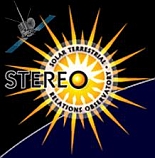STEREO IMPACT
Latest News: IMPACT Team Releases New Level 2 (key parameter) Merged Magnetic Field and Solar Wind Parameter Data Set
The Solar Terrestrial Relations Observatory (STEREO) employs two nearly identical observatories in orbit about the Sun (one moving ahead of the Earth, and one moving behind) to provide the first-ever 3-D images of coronal mass ejections (CMEs). These stereo images are supplemented by multi-point in situ measurements of solar wind and CME plasma and the energetic particles accelerated in association with solar eruptions, and by multipoint observations of radio bursts occurring in these events.
IMPACT consists of two instrument suites. The boom suite which includes MAG, SWEA, and STE. And the SEP suite which includes SEPT, SIT, LET, and HET.
MAG
measures the three components of the vector magnetic field in the range
+/- 512 nT with 0.1 nT accuracy at 1/8 second time resolution from two
vantage points.
MAG INSTRUMENT SITE
MAG data may also be found at the CDAWeb site
here.
SWEA
measures the core (bulk solar wind) and halo (strahl) electron fluxes
with a 360 X 60 degree or better field of view at energies 20 to
1000eV, with angular resolution of at least 45 X 45 degrees and
1-minute sampling from two vantage points.
gate io
STE measures the suprathermal halo/super-halo electron fluxes over electron energies 5 to 100 keV, spanning the gap between SWEA and SEP electron measurements, along the nominal interplanetary field direction with at least 1 minute time resolution from two vantage points. Measurements include fluxes, energy spectra, and direction of arrival. NOTE: STE-U is not working.
SEPT consists of two dual, double-ended magnet/foil solid state detector particle telescopes that cleanly separate and measure electrons in the energy range 20-400 keV and protons from 20-7000 keV, while providing anisotropy information through use of several fields of view. Each SSD detector in SEPT is 300 microns thick and 0.53 cm2 in area. A rare-earth permanent magnet is used to sweep away electrons for ion detection, while a parylene foil transmits electrons but stops protons. SEPT is divided into two pieces for field-of-view reasons. The SEPT-E telescope is housed with the rest of the SEP Package on the body of the spacecraft. It looks in the ecliptic plane along the Parker Spiral magnetic field direction, both forward and backward. SEPT-N/S is housed separately at a different spacecraft location, and looks out of the ecliptic plane perpendicular to the nominal magnetic field, both north and south. The viewing cones for the SEPT telescopes are each ~60 degrees.
SEPT INSTRUMENT SITE
SIT is a time-of-flight ion mass spectrometer that measures elemental composition of He-Fe ions over the energy range ~30 keV/nucleon to 2 MeV/nucleon. The Field of View angles are 17X44 degrees, with the 44 deg angle in the ecliptic plane, centered ~60 deg from the spacecraft-Sun line to avoid sunlight while still intercepting insignificant numbers of Parker Spiral field controlled energetic ion fluxes The telescope analyzes ions that enter through thin entrance foils and stop in a solid state detector. A time-of-flight approach for determining the composition utilizes start and stop times obtained from secondary electrons entering a microchannel plate system. The MCP and SSD areas are each 6.0 cm2. The SIT geometric factor allows study of even small SEP events.
SIT INSTRUMENT SITE
LET is a special double-fan arrangement of 14 solid state detectors designed to measure protons and helium ions from ~1.5 to 13 MeV/nucleon, and heavier ions from ~2 to 30 MeV/nucleon. LET uses a standard dE/dx vs. E technique, identifying particles that stop at depths of ~20-70 microns and ~70-2000 microns corresponding to two general energy ranges. The large field of view spans from 20 deg above to 20 deg below the ecliptic plane, and extends 65 deg to either side of the forward and backward Parker Spiral field directions in the ecliptic plane. LET's large geometric factor also ensures the detection of even small SEP events.
LET INSTRUMENT SITE
HET also uses the solid state detector, dE/dx vs. E approach, but in a six-detector, more traditional linear arrangement designed to measure protons and helium ions to 100 MeV/nucleon, and energetic electrons to 5 MeV. HET identifies particles that stop at depths of 1 to 8 mm in the detectors. Some information will also be obtained on heavier nuclei up through Fe using the dE/dx vs E signatures and ranges together, and penetrating particles will be analyzed. HET's field of view covers a 47.5 degree cone around the Parker Spiral field direction.
HET INSTRUMENT SITE
HET SEP ELECTRON EVENT LISTS
For more general information about the STEREO mission, and for verified science data products, please visit the following sites:
